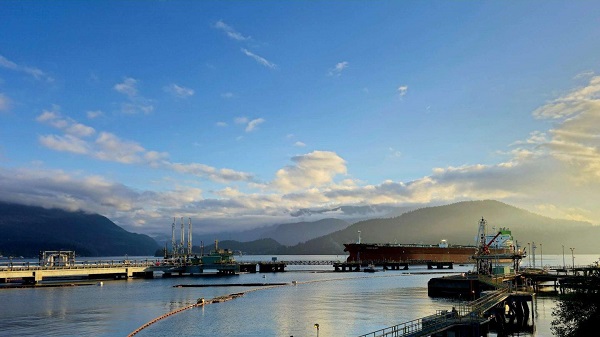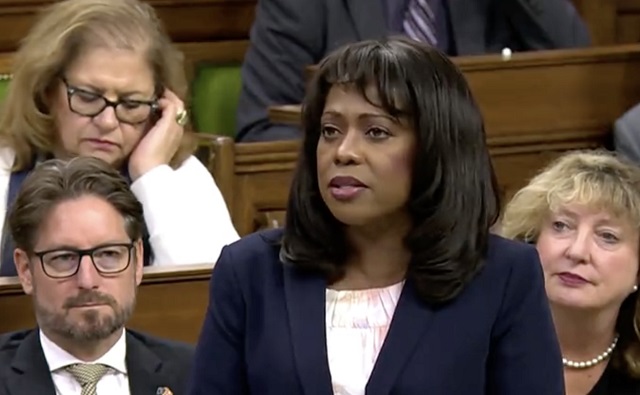Energy
Global fossil fuel use rising despite UN proclamations

From the Fraser Institute
By Julio Mejía and Elmira Aliakbari
Major energy transitions are slow and take centuries, not decades… the first global energy transition—from traditional biomass fuels (including wood and charcoal) to fossil fuels—started more than two centuries ago and remains incomplete. Nearly three billion people in the developing world still depend on charcoal, straw and dried dung for cooking and heating, accounting for about 7 per cent of the world’s energy supply (as of 2020).
At the Conference of the Parties (COP29) in Azerbaijan, António Guterres, the United Nations Secretary-General, last week called for a global net-zero carbon footprint by 2050, which requires a “fossil fuel phase-out” and “deep decarbonization across the entire value chain.”
Yet despite the trillions of dollars already spent globally pursuing this target—and the additional trillions projected as necessary to “end the era of fossil fuels”—the world’s dependence on fossil fuels has remained largely unchanged.
So, how realistic is a “net-zero” emissions world—which means either eliminating fossil fuel generation or offsetting carbon emissions with activities such as planting trees—by 2050?
The journey began in 1995 when the UN hosted the first COP conference in Berlin, launching a global effort to drive energy transition and decarbonization. That year, global investment in renewable energy reached US$7 billion, according to some estimates. Since then, an extraordinary amount of money and resources have been allocated to the transition away from fossil fuels.
According to the International Energy Agency, between 2015 and 2023 alone, governments and industry worldwide spent US$12.3 trillion (inflation-adjusted) on clean energy. For context, that’s over six times the value of the entire Canadian economy in 2023.
Despite this spending, between 1995 and 2023, global fossil fuel consumption increased by 62 per cent, with oil consumption rising by 38 per cent, coal by 66 per cent and natural gas by 90 per cent.
And during that same 28-year period, despite the trillions spent on energy alternatives, the share of global energy provided by fossil fuels declined by only four percentage points, from 85.6 per cent to 81.5 per cent.
This should come as no surprise. Major energy transitions are slow and take centuries, not decades. According to a recent study by renowned scholar Vaclav Smil, the first global energy transition—from traditional biomass fuels (including wood and charcoal) to fossil fuels—started more than two centuries ago and remains incomplete. Nearly three billion people in the developing world still depend on charcoal, straw and dried dung for cooking and heating, accounting for about 7 per cent of the world’s energy supply (as of 2020).
Moreover, coal only surpassed wood as the main energy source worldwide around 1900. It took more than 150 years from oil’s first commercial extraction for oil to reach 25 per cent of all fossil fuels consumed worldwide. Natural gas didn’t reach this threshold until the end of the 20th century, after 130 years of industry development.
Now, consider the current push by governments to force an energy transition via regulation and spending. In Canada, the Trudeau government has set a target to fully decarbonize electricity generation by 2035 so all electricity is derived from renewable power sources such as wind and solar. But merely replacing Canada’s existing fossil fuel-based electricity with clean energy sources within the next decade would require building the equivalent of 23 major hydro projects (like British Columbia’s Site C) or 2.3 large-scale nuclear power plants (like Ontario’s Bruce Power). The planning and construction of significant electricity generation infrastructure in Canada is a complex and time-consuming process, often plagued by delays, regulatory hurdles and substantial cost overruns.
The Site C project took around 43 years from initial feasibility studies in 1971 to securing environmental certification in 2014. Construction began on the Peace River in northern B.C. in 2015, with completion expected in 2025 at a cost of at least $16 billion. Similarly, Ontario’s Bruce Power plant took nearly two decades to complete, with billions in cost overruns. Given these immense practical, financial and regulatory challenges, achieving the government’s 2035 target is highly improbable.
As politicians gather at high-profile conferences and set ambitious targets for a swift energy transition, global reliance on fossil fuels has continued to increase. As things stand, achieving net-zero by 2050 appears neither realistic nor feasible.
Authors:
Energy
ELZABETH MAY HAS IT WRONG: An Alberta to Prince Rupert Oil Pipeline Will Contribute to Greater Global Oil Tanker Safety

From Energy Now
By Jim Warren
There she goes again. For the second time in three weeks Elizabeth May has tried to mislead Canadians. Most recently May incorrectly claimed oil tankers operating from Prince Rupert would be sailing through Canada’s most dangerous waters and the fourth most dangerous waters in the world.
The previous instance of deception was May’s false claim that Canada was legally bound by an international treaty to meet its green transition and net zero commitments. She told that whopper on November 17, the day the House of Commons narrowly approved the Liberal budget.
Since misconstruing the treaty, May has drawn media attention to a video she released which claims tankers leaving the proposed Northern Gateway 2.0 terminal will travel through the allegedly perilous Hecate Strait which separates the Haida Gwaii islands (formerly the Queen Charlotte Islands) from the West coast of the B.C.
Somebody better tell the B.C. Ferry Service their regularly scheduled runs across the Hecate Strait from Prince Rupert to Haida Gwaii are putting lives at risk.
Online fact checkers have determined the hyperbole regarding the safety of the strait traces back to 1992 and an extraneous comment in the Marine Weather Hazards Manual, West Coast Edition : A Guide to Local Forecasts and Conditions.
The manual indicates high winds can develop quickly over the strait making sailing hazardous for smaller vessels. This is followed by an unsubstantiated comment about it being the most dangerous waterway in Canada. Students of late 20th century history assume the comment is an embellishment based on an anecdote that was improperly inserted by whoever wrote the manual. It is not any sort of official ranking.
Oil tankers are obviously nothing like the small vessels that can encounter problems in the strait. And besides that, loaded tankers leaving Prince Rupert can avoid the Hecate Strait altogether by way of the Dixon Entrance which connects Prince Rupert to the wide open Pacific.
The map shown below was produced by The Hub, one of the fact-checking websites which has challenged May’s false claims about the hazards facing oil tankers at the Northern end of B.C.’s West coast.

Source: Falice Chin (2025, November 25).
https://thehub.ca/2025/11/25/fact-check-elizabeth-mays-tanker-ban-claims-dont-add-up/
May’s outright misrepresentations of the Paris Climate Agreement and the safety of shipping out of Prince Rupert reflect the environmental movement’s all too frequent exaggerations about the dangers posed by climate change and conventional energy.
The argument which follows shows how the Prince Rupert oil pipeline terminal can play a role in the effort to increase global oil tanker safety and reduce the danger of oil spills
If it weren’t for the dark (aka shadow) tanker fleets transporting Russian and Iranian oil, the environmentally alarmed could rest a lot easier about oil tanker safety. Over the past several decades there have been tremendous improvements in oil tanker design and safety technology.
The last major oil tanker spill on the West coast of North America was the 1989 Exxon Valdez oil spill, which resulted in 240,000 barrels of crude being dumped into Alaska’s Prince William Sound.
The Exxon Valdez disaster prompted the US Congress to pass the Oil Pollution Act of 1990. The Act required the gradual phasing in of double hulled construction for new oil tankers. The US Coast Guard claims that if the Exxon Valdez had been a double hulled vessel it would have cut the amount of oil spilled by 60%.
The US double hull requirement has since become the global standard for the design of new, large oil tankers. That being said, there are a number of countries and shipping companies that operate outside the confines of international best practices. These are the countries and companies which facilitate the operation of the world’s dark fleets.
In response to Russian’s invasion of Ukraine in February 2022, the EU, NATO members and several other G20 countries imposed a set of trade and financial sanctions on Russia. The 2022 package was much tougher than sanctions imposed on Russia after its 2014 occupation of the Donbas and seizure of the Crimea.
The new sanctions imposed in 2022 included restrictions on Russia’s ability to export oil into international markets. While some of the sanctions soon proved to be rather toothless, efforts to prevent the world’s major shipping insurers like Lloyd’s of London from insuring ships carrying Russian oil were more successful. Owners of the world’s modern tanker fleets refused to transport Russian crude. It was simply too risky. A tanker accident and oil spill, especially along a coast line or near a major coastal urban centre can be monumentally expensive. Companies operating uninsured or poorly insured tankers would also find it difficult to obtain bank financing and new investors.
It was assumed that the oil sanctions would damage the Russian economy and seriously handicap its ability to wage war against Ukraine. After all, as US Senator John McCain famously said, “Russia is a gas station masquerading as a country.” Oil and natural gas have kept the Russian economy afloat since the collapse of the Soviet Union.
Russia’s friend, Iran, has been dodging oil sanctions for decades and happily shared that know how with its pals at the Kremlin. For starters, Russia’s oil exporters needed to gain access to tankers owned by operators who didn’t worry about insurance or if they were insured it was by shady companies operating out of countries that weren’t too worried about things like oil spills.
In relatively short order, Russian oil interests acquired a fleet of dark tankers which could be operated outside the bounds of properly insured shipping. Over the course of 2022 and 2023, the market price for old, used oil tankers which had outlived their best before dates but could still float more than doubled. Many of the derelict rust buckets lacked modern double hull construction.
The size of the world’s sanctions dodging dark fleets doubled after February 2022. Today it is estimated to be somewhere between 1,000 to 1,400 ships. Most of the ships are oil tankers but some are container vessels.
Since the vast majority of the older ships in the dark fleet are small to mid-size tankers it makes sense to transfer the Russian oil into larger tankers, on the open ocean, far from prying eyes. This reduces overall shipping costs and facilitates laundering of the oil. Once it is in the larger tanker Russian oil looks like anybody else’s oil. While transferring oil from ship to ship can and is done very safely, it becomes less safe when one of the ships is a floating pile of scrap iron.
In 2023, The Economist reported that Malaysia and the UAE were suddenly selling more than twice as much oil as they are capable of producing in a year. It’s alleged they are operating as middleman states which facilitate the laundering of Russian oil. The Economist claimed that Russian oil revenues fell in 2023. However, they returned close to pre-sanctions levels by the end of 2024. In other words, the sanctions have been a flop.
Despite the practice of transferring oil to larger ships, most Russian oil is transported all the way from Russia to final customers on smaller shadow fleet ships. Many of the ships in the dark fleet are chronic leakers and vulnerable to larger spill events. Luckily for the Russians, there are ports in China and several developing countries like India, and Malaysia willing to accept shadow fleet shipments. Some port operators are prepared to accept tankers insured by sketchy or fake insurers. Port authorities in these countries are willing to look the other way when antique tankers hemorrhage oil into their harbours. Not all spills and leaks are reported, so the full extent of the environmental harm is unknown.
It’s only a matter of time before one or more of the floating sieves in the dark tanker fleet causes a major oil spill in international waters that captures the world’s attention. Denmark has recently taken action against defective dark fleet tankers transporting Russian oil from the Baltic to the Atlantic. The ships have to pass through narrow straits controlled by Denmark where there is a somewhat higher risk of accidents. Last month, the Royal Danish Navy began randomly stopping and inspecting tankers carrying Russian oil.
The takeaway worth noting here is that should Northern Gateway 2.0 be approved and actually built, every barrel of oil shipped from the Prince Rupert terminal will be a barrel that Russia cannot sell via its shadow fleet. It will be a barrel of oil transported by double hulled, state of the art tankers. Furthermore every barrel of oil shipped from Prince Rupert will be a barrel of oil that will not subsidize Russia’s war against Ukraine.
Elizabeth May, you are wrong again. The oil pipeline from Alberta to Prince Rupert stands to contribute to greater global tanker safety in part because it can contribute to a loss of Russia’s market share in the Asia Pacific region. Shipments from Canada crossing the Pacific using large, modern tankers will cost far less than the cost of shipping over longer distances using smaller (less safe and efficient) ships to transport oil from Russia to that part of the world. Canadian producers should have the ability to sell their oil profitably at a lower price than Russian competitors need to obtain due to their much higher transportation costs.
Of course, profitability for Canadian exporters will depend on how high any carbon or other environmental taxes Ottawa imposes might be.
Business
Oil tanker traffic surges but spills stay at zero after Trans Mountain Expansion

From the Canadian Energy Centre
Bigger project maintains decades-long marine safety record
The Trans Mountain system continues its decades-long record of zero marine spills, even as oil tanker traffic has surged more than 800 per cent since the pipeline’s expansion in May 2024.
The number of tankers calling at Trans Mountain’s Westridge Marine Terminal in the Port of Vancouver in one month now rivals the number that used to go through in one year.
A global trend toward safer tanker operations
Trans Mountain’s safe operations are part of a worldwide trend. Global oil tanker traffic is up, yet spills are down, according to the International Tanker Owners Pollution Federation, a London, UK-based nonprofit that provides data and response support.
Transport Canada reports a 95 per cent drop in ship-source oil spills and spill volumes since the 1970s, driven by stronger ship design, improved response and better regulations.
“Tankers are now designed much more safely. They are double-hulled and compartmentalized to mitigate spills,” said Mike Lowry, spokesperson for the Western Canada Marine Response Corporation (WCMRC).
WCMRC: Ready to protect the West Coast

One of WCMRC’s new response vessels arrives in Barkley Sound. Photo courtesy Western Canada Marine Response Corporation
From eight marine bases including Vancouver and Prince Rupert, WCMRC stands at the ready to protect all 27,000 kilometres of Canada’s western coastline.
Lowry sees the corporation as similar to firefighters — training to respond to an event they hope they never have to see.
In September, it conducted a large-scale training exercise for a worst-case spill scenario. This included the KJ Gardner — Canada’s largest spill response vessel and a part of WCMRC’s fleet since 2024.
“It’s part of the work we do to make sure everybody is trained and prepared to use our assets just in case,” Lowry said.
Expanding capacity for Trans Mountain

The K.J. Gardner is the largest-ever spill response vessel in Canada. Photo courtesy Western Canada Marine Response Corporation
WCMRC’s fleet and capabilities were doubled with a $170-million expansion to support the Trans Mountain project.
Between 2012 and 2024, the company grew from 13 people and $12 million in assets to more than 200 people and $213 million in assets.
“About 80 per cent of our employees are mariners who work as deckhands, captains and marine engineers on our vessels,” Lowry said.
“Most of the incidents we respond to are small marine diesel spills — the last one was a fuel leak from a forest logging vessel near Nanaimo — so we have deployed our fleet in other ways.”
Tanker safety starts with strong rules and local expertise

Tanker loading at the Westridge Marine Terminal in the Port of Vancouver. Photo courtesy Trans Mountain Corporation
Speaking on the ARC Energy Ideas podcast, Trans Mountain CEO Mark Maki said tanker safety starts with strong regulations, including the use of local pilots to guide vessels into the harbour.
“On the Mississippi River, you have Mississippi River pilots because they know how the river behaves. Same thing would apply here in Vancouver Harbour. Tides are strong, so people who are familiar with the harbor and have years and decades of experience are making sure the ships go in and out safely,” Maki said.
“A high standard is applied to any ship that calls, and our facility has to meet very strict requirements. And we have rejected ships, just said, ‘Nope, that one doesn’t fit the bill.’ A ship calling on our facilities is very, very carefully looked at.”
Working with communities to protect sensitive areas
Beyond escorting ships and preparing for spills, WCMRC partners with coastal communities to map sensitive areas that need rapid protection including salmon streams, clam beds and culturally important sites like burial grounds.
“We want to empower communities and nations to be more prepared and involved,” Lowry said.
“They can help us identify and protect the areas that they value or view as sensitive by working with our mapping people to identify those areas in advance. If we know where those are ahead of time, we can develop a protection strategy for them.”
-

 MAiD2 days ago
MAiD2 days agoFrom Exception to Routine. Why Canada’s State-Assisted Suicide Regime Demands a Human-Rights Review
-

 Energy2 days ago
Energy2 days agoUnceded is uncertain
-

 Business2 days ago
Business2 days agoCarney government should privatize airports—then open airline industry to competition
-

 Alberta1 day ago
Alberta1 day agoCarney’s pipeline deal hits a wall in B.C.
-

 Alberta1 day ago
Alberta1 day agoAlberta Sports Hall of Fame Announces Class of 2026 Inductees
-

 Censorship Industrial Complex1 day ago
Censorship Industrial Complex1 day agoConservative MP Leslyn Lewis slams Liberal plan targeting religious exemption in hate speech bil
-

 Business2 days ago
Business2 days agoWhat’s Going On With Global Affairs Canada and Their $392 Million Spending Trip to Brazil?
-

 Business2 days ago
Business2 days agoIs Carney Falling Into The Same Fiscal Traps As Trudeau?










